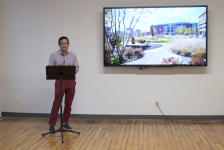Last post, I listed some questions to ask in an interview. Since then, I attended the education session “Today’s “New” Job Market: Current Trends and Perceptions in the Hiring Process” at the ASLA professional conference in San Diego so that I could report back what they said to you. Below is a consolidation of my notes. The opinions here are those of the panelists and of employers they had surveyed about what was desired from emerging professionals.
You may have noticed with the Interview with an Employer posts that opinion varies from person to person, so when you read this, it may not indicate what your next interviewer is looking for, but is merely a good starting point.
Hand graphics: plan graphics are the most important, followed by the ability to produce quick sketches. Good rendering abilities are simply expected, and the ability to produce perspectives is less critical than the above. The ability to convey an idea quickly far outweighs the ability to produce polished, finished graphics. They want to see your process graphics!
Technical knowledge: Grading and drainage, an understanding of materials and methods, plant materials, storm water and construction processes (about equal importance, not as separate categories), irrigation.
“It is completely okay to tell us what you don’t know”
Design: They noted that creativity is the most important aspect of design, and also that it can be difficult to show your creativity when your early professional projects may not show a lot of your own work and your student work shows a learning process, that you may have exceeded in skill since you did that work.
In showing design abilities, the most important thing is showing your creativity, followed by problem solving skills, then having a sense of scale, and an understanding of local context. Their suggestion for demonstrating creativity was to design a “nice, creative portfolio” with a coordinating cover letter (on letterhead!) and make sure that you follow-up. They noted that your portfolio with the rest of your marketing materials are the “fabric that shows who you are.”
“Your portfolio is a story about you.”
Professional character: Appropriate business attire (better to be overdressed for the interview than too casual), efficient, ability to be part of a tem, and to perform unsupervised work, compatibility with the rest of the staff, pleasant personality. Ambition and organization were on the list, surprisingly listed as lower priorities than all of the above.
Additional skills: Problem solving and integration of your own abilities in projects, writing, a good attitude and a passion for the profession, good speaking skills.
Deal breakers: Inability to communicate effectively, poor work, inappropriate interview conduct, overstating your qualifications, mis-representing your role in projects.
“We expect you to have a learning curve, and are hiring you for your other talents.”
One of the panelists gave this example (paraphrased): Suppose you are an emerging professional and while looking for work, you designed and built a deck for your mom. The deck came out awful, really horrible, but you learned a thing or two about decks and construction in the process. You may be thinking that you should not show this deck in your portfolio, but I think you should. I want to know what you learned, and how you solved the problems that came up.
Employers (according to the panel) want to see the process by which you arrived at a solution. They want to see the ten crazy ideas, the refining of those ideas, and where the solution came from. Remember showing your work in Geometry class? Same thing. They recommend keeping your early quick sketches and including them in your portfolio.
“It is not against the rules to show us good stuff. If your student work wasn’t that good, do it again.”
Greatest false expectation: High salary. The panel made a point of saying that employers are anxious that the people they interview are looking for a lot of money, and they don’t realize that most emerging professionals are more interested in a chance to work at all. Their advice is never to bring up salary because employers already have anxiety over this and the interview should be about finding the right fit and a chance to prove yourself. Let them know you want an opportunity for learning and growth.
“We know the people we want to hire already.”
Hiring: Employers aren’t advertising jobs much, but when they do, they rely on their own websites, word of mouth, ASLA’s Joblink, and networking. They know the people who are active in professional organizations, the people others have recommended, and they’ve kept information on the best applicants.
Worst way to try to get their attention: Sending a letter with a CD. The panel considered this a huge waste of time and suggested that applicants take the simple step of calling and asking for permission to send these materials. If you call but don’t get the person you want, talk to the person you got. A staff person can be just as good to talk to as the boss, and if you can make a connection there, the staff person can pass your information along and may be willing to answer questions you have about the company. Remember, that staff person has a job there; they’ve already succeeded at what you are trying to do.
All agreed that eventually, they want to see a hard copy of your portfolio, a website or CD is not enough.
One last thing: a couple of weeks ago, ASLA launched the Emerging Professionals section of their website; it is listed under the drop-down menu from the membership section.
Till next time…
Published in Blog







